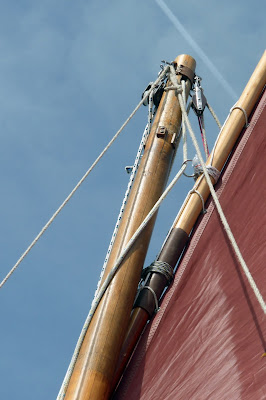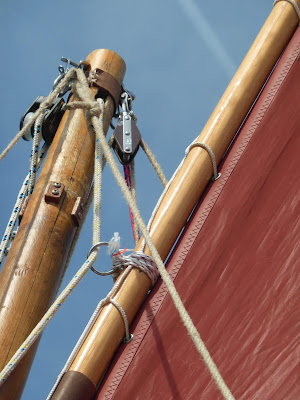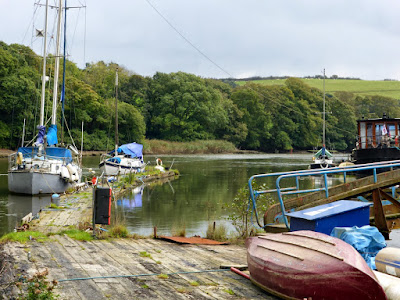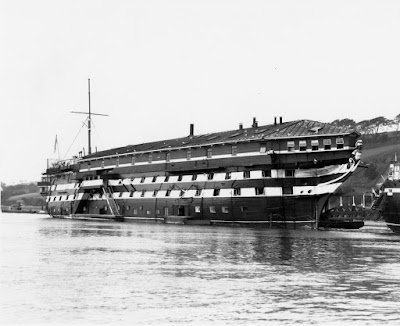"A sailor is an artist whose medium is the wind”
Webb Chiles
Such words of
wisdom casually encroach on Skipper’s thoughts as he surveys his pilotage notes
and assesses the weather around him.
From the
comfort of his 14’ open boat ‘Arwen’, securely tied on to his favourite yellow
mooring buoy at the southerly end of the Saltash Bridge trots; and now
substantially fortified by hot tea and cheese and marmite sandwiches, it has
not escaped skipper’s notice that the wind forecasts in his notebook fail to correspond
with the ‘real’ breezes eddying around him.
Yet again he
has forgotten that whilst winds may well be from the SSW in Plymouth Sound and
up the Hamoaze, they too often have an irksome habit of blowing directly
westwards down the Lynher channel when he decides to venture up it. Or perhaps,
he muses, it could just be the influence of topography around him.
Today’s
cruising goal, one of his favourite ‘backwater treasures’, is a traditional boat
yard. Hidden away in a 20-acre former
quarry where the upper Lynher narrows and winds its way through steep sided,
oak wooded valley, Treluggan is in Skipper’s humble opinion, a ‘proper’ boatyard; a place where highly
skilled craftsmen combine traditional woodworking skills with modern
methodologies and materials.
Looking along the old wooden pontoons at Treluggan
Aerial drone shot of Treluggan Boat yard
Surrounded by
stunning natural beauty, fabulous wildlife and fascinating industrial
archaeology, there is a deep tranquillity to be had from tying up alongside its
crumbling, wooden planked, mooring pontoon. Here, in the narrow mud bank lined
channel, natures privileges abound; the diving acrobatics of majestic blue and
russet orange kingfishers, the ‘snuffling’ antics of small salmon splashing in the
shallows, shovelling up the unsuspecting small fry and long legged, motionless
white egrets, a stark contrast against the chocolatey brown thick mud. It is he muses, such a shame that many boats
never get to see such wonders, so quick are they to drop their hooks in the
popular deep water Dandy Hole anchorage further downriver.
Putting reveries
aside, it slowly dawns on the small boat adventurer that extensive ‘wind
artistry’ will be required today. Lengthy periods of up-river tacking, finesse
in sail trimming and plenty of agility, will be required if he is to reach this
picturesque journey’s end.
Returning to his
pilotage and passage planning thoughts and wishing to arrive at Treluggan at
the top of the 4.9m high tide around 1700, Skipper knows it is pointless
entering the Lynher much before 1330pm. Although he only draws 10” with
centreboard raised and can easily take the soft mud ground, the helpful passage
planning notes downloaded from the boatyard site a few nights before recommend
small boats should enter the final mile of channel from 1.5 hrs before high
water. So, quick mental calculus suggests it will be 1530 at the earliest before
skipper can turn to starboard at the confluence of the Tiddy and Lynher rivers
to begin the winding passage up to Treluggan, past thriving salt marshes and
beneath wonderous Victorian engineered railway viaducts.
With no need
to rush, and a wary eye on the wind, the fledgling dinghy cruiser usefully
fills the hour before departure with ‘boat-keeping’ tasks. One or two frayed halyards
where whippings have ‘mysteriously’ undone need re-seizing and so he reaches
for his little toolkit ditty bag stored in the port forward thwart locker to
find needles, thread and bosun’s palm.
Afterwards, bottom
boards are sponged clean; the annoying small pieces of gravel that find their
way onto his boat and gouge his newly done paintwork, thrown back overboard. Dry
bags are shuffled around and bungeed down along boat sides to give better trim
and a few pleasant minutes are passed admiring the foot stirring antics of a
long-legged grey heron as it flushes out and rapidly harpoons unwary flounders
and eels at water’s edge.
The French use
a lovely phrase, ‘Trouvaille’ to describe
that ‘chance encounter with something
wonderful’. Skipper’s few minutes of ‘trouvaille’
end as the lanky heron, spooked by a rattling train crossing Brunel’s ancient
lenticular trussed bridge, soars aloft in lazy circles, its slow beating wings
carrying it onto a tree top perch a few hundred metres further upriver. Feeling a momentary sense of loss, the sailor
quickly checks the winds once more and mentally notes his scrawled passage plan
notes.
“Leg 1 – Beggar Island
red port can on 256M at 0.4NM against westerly tidal flow of 0.4kts”.
His first
checkpoint up river yet he knows in reality that this bearing and distance will
become meaningless as he starts his rapid tacking upwind to reach the waypoint.
Mizzen raised,
the little boat drifts round to point into the stiffing breeze. Aft of the
centre-case, comes a sudden flurry of activity as skipper hauls on halyards and
sheets. The standing lug sail top yard shoots upwards to its near vertical
alignment against the mast; luff tension is applied and snotter adjusted to
gain decent lower sail shape. Ropes are tidied into thwart mounted halyard bags
before rudder is lowered, centreboard set and painter released in one fluid set
of movements. Dismissing the need for a potential
reef in mainsail earlier on, he has already visualised his departure course
away from the buoy.
‘Away on a
southerly reach back down the upper Hamoaze between the two moored lighters
west of Carew point, before tacking around and heading back up’.
Jib unfurls
with rattling sheets, the red furling line snaking away through the cockpit
coaming fairlead. The white hulled dinghy with its burgundy sheer plank makes a
steady 3.5kts on the return reach to the Lynher red port can marker before a series
of short tacks bring boat and skipper upriver, past Wearde Quay.
Had Skipper
and Arwen been sailing past this point in the late 1800’s they would have
passed HMS Defiance at anchor off this quayside. The last wooden three decker
ship launched for the Royal Navy, she may never have seen service as a line of
battle ship, but her history is still an interesting one. In After becoming the
permanently moored training school for torpedoes and mines in 1884, her
commanding officer, Captain Henry Jackson, made a series of pioneering radio
transmissions in 1896, so becoming the first Briton to use radio for practical
communication from the deck of a ship. During WW1, Defiance was an army
training camp and later in 1918 was converted to a Queen Alexandra
convalescence centre for battle casualties. Sadly, in 1931, she met her end,
dismantled and sold for scrap.
Captain Jackson
With no wreck to view and only a row of renovated
cottages to mark the quayside, Skipper is content, that based on old photos he
found on the internet, HMS Defiance must have been a remarkable sight. So
important and busy was she in her heyday that the Great Western Railway even
built a station halt behind her on the main Paddington – Penzance line. ‘Defiance
Halt’, long since closed.
Between
Beggar Island and Sand Acre Point, skipper tacks upriver with care, keeping a
wary eye on the water colour beneath him as he approaches the northern shore. Shallow
water above oozing mudflats will catch the centreboard of the unwary sailor and
whilst grounding oneself on a rising tide is a mild and somewhat irritating
inconvenience, it is not something skipper is keen to do under the full gaze of
the ‘Jupiter Point’ naval trainees, who are out in force practising their MOB
procedures in small ribs.
Courtesy of Navy Times
He is especially
very keen NOT to become the day’s ‘teaching
point’ for accompanying Chief Petty officers and so he further shortens his
tack runs.
Courtesy of Navy Times
Whilst it is fun for short periods
of time to ‘guess’ the depths and repetitively duck back and forth beneath
swinging boom and mainsail, skipper is of an age now where back and legs tire
quickly and the ‘novelty’ soon wears off. He is not, never was and never will
be a dinghy racing type!
Today the fates take pity, rewarding him with a
sudden albeit brief wind shift to a more south westerly direction which enables
him to complete a ‘longer’ tack out past the training school, the mine sweeper HMS
Brecon moored midstream, and over to the northerly ‘Anthony’ green starboard
channel can. It is a move that particularly delights skipper as it affords him
a closer ‘inside’ view of Forder lake and the hamlet of Anthony Passage.
HMS Brecon
In this
stretch of water, it is not hard to see how the shift from Hamoaze to Lynher is
like cutting ties with civilization and entering a past historical time. The change
of pace and scenery, from dockyards, incinerators, lumbering chain ferries and
stark urban landscapes to sceneries not out of place in the early 1800’s or
even medieval times, is most welcome.
Forgotten
creeks, old wooden wreck hulks, crumbing Victorian quaysides, the ‘Capability
Brown’ designed gardens of old country house estates and glimpses of ancient
medieval Motte and Bailey Norman castles high on farmed hillsides always excite
this skipper.
Looking over Forder Lake towards the river Lynher
To the sounds
of rattling blocks, flapping sails and knocking centreboard, Arwen’s gracefully
curved forefoot stem slows its slicing through the wavelets as skipper eases
mainsheet, tightens mizzen and brings bow into wind. Gently drifting backwards,
he now has time to admire the industrial archaeology of Forder Lake. From early
medieval times right up to the twentieth century, the history of flour milling,
fulling, market gardening, lime burning, roadstone quarrying and concrete block
making have left their indelible mark on this pretty conservation area and area
of outstanding natural beauty (ANOB).
Seduced by splendid
agricultural scenery on rolling hills, it is too easy to sail by and miss this inlet
with its old mill house and pond where the thirteenth century tenants of Trematon
Manor bought their grain to be milled; where seventeenth century waterwheels
enabled fullers to clean, shrink and thicken woven cloth; and where nineteenth
century boats bought Devonport Dockyard dung and street sweepings upriver to be
dumped on the quayside for local farmers to carry away in carts. Natural
fertiliser for the local market garden farms!
Some twenty miles long, rising 280m high on Bodmin Moor and with 75% of
its catchment given over to dairy farming today, Skipper likes to think of the
river Lynher as a ‘hard working’ waterway rich in a history that he never tires
of discovering.
As winds
shift back to WNW, he completes a longer tack south across the channel. Over
the transom he gains fleeting glimpses of Trematon castle above Forder Lake.
Privately owned, he sadly has yet to reach a station in life where he would be
granted a personal invitation to visit such a worthy historical site. Built on
a former ancient roman fort, after the Norman conquest, the motte and bailey castle’s
30’ high, 10’ thick walls were once home to Drakes treasures from his
circumnavigation. Spanish plunder, safely kept there, whilst the ‘pirate’
awaited aboard his own ship for news that he was still in his fair Queen’s good
books!
Aerial view of Trematon castle and beyond is Forder Lake
with its GWR viaduct, mill pond and old mill houses
Ahead of skipper,
the wooded gardens of Antony house, owned by the National Trust and still lived
in by the Carew Poles, a family who can trace their lineage back to the 1400’s
and Carew Castle in Pembrokeshire.
Antony House
Although a geographer by heart, skipper does
occasionally admit to being lured by the dark side of the force and the attractions
of being a historian. Thus, the Lynher with its stimulating histography is one
of skipper’s favourite cruising haunts. Why, it was here in 981AD that the
Saxons crossed the river, forcing ancient British Celts back deeper into
Cornwall (so unwittingly, skipper feels, starting the Cornish struggle for ‘independence’
from the domineering, hugely omnipresent Anglo Saxon and later Norman, English
and London centric governments. A unique
Celtic seafaring, mining and farming history, with a culture and language more
in common with Wales, Ireland and Brittany, skipper, as a Welshman, has some
sympathy with this longing that is so entwined in the DNA of many Cornish
people).
A cormorant,
in the path of the rapidly approaching little boat prudently its flap wings and
sprints its webbed feet furiously across the water surface to gain momentum and
lift, thus intruding on Skippers musings about cultural politics. Breaking away
a few metres ahead of looming bow, the cormorant in a welter of spray, whooshes
its way southwards to find another less disturbed fishing ground.
Meanwhile, skipper
pauses briefly to plot his position on chart and to search out his next
waypoint mark with binoculars. Building forward momentum once more, he
unhurriedly turns tiller to leeward and ducks beneath swinging boom and
fluttering mainsail. Jib is backed, bringing bow through the wind more quickly
and he checks his steering compass.
‘291M, 0.9NM to ‘Ince’
green starboard buoy’.
Course
details successfully scrawled in passage logbook, he momentarily relaxes as his
little boat surges towards deeper channel waters. Sails trimmed and tiller
tamer set, he pours a tea from his trusty flask and savours the last of his
cheese and marmite sandwiches.
Life is good.
Or, to paraphrase the great Joshua Slocum,
‘the days pass happily
with me wherever my [little boat] sails’






























































